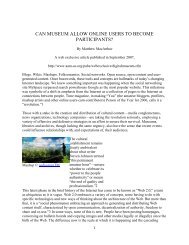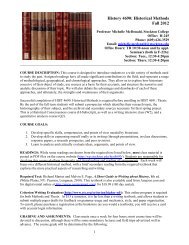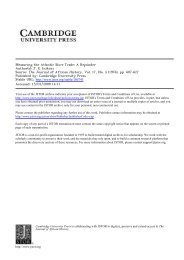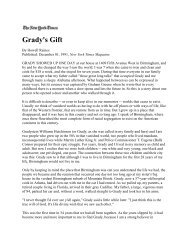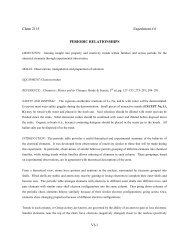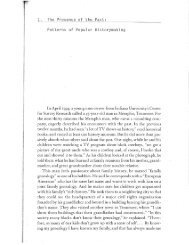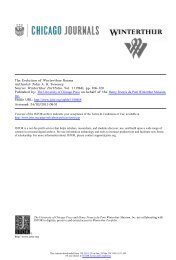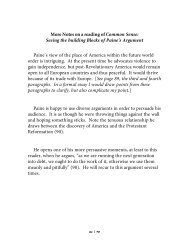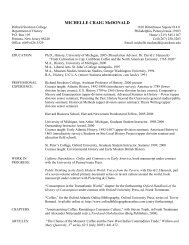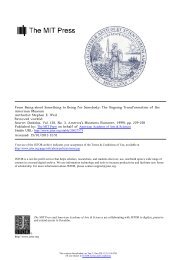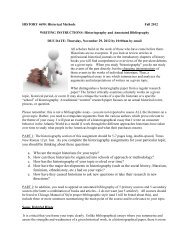What Is the Object of This Exercise? A Meandering Exploration of ...
What Is the Object of This Exercise? A Meandering Exploration of ...
What Is the Object of This Exercise? A Meandering Exploration of ...
Create successful ePaper yourself
Turn your PDF publications into a flip-book with our unique Google optimized e-Paper software.
180 Elaine Heumann Gurian<br />
mine <strong>the</strong> access to that material. In many cultures sacred cer<br />
emonies are open to all, and <strong>the</strong> objects in use are available for<br />
view in museum<br />
settings, but that too may change. For ex<br />
ample,<br />
in Jewish tradition, Torahs once desecrated are sup<br />
posed<br />
to be disposed <strong>of</strong> by burial in a<br />
prescribed<br />
manner. Yet<br />
some <strong>of</strong> <strong>the</strong>se are available for view, most<br />
notably<br />
at <strong>the</strong> United<br />
States Holocaust Memorial Museum. There may come a time<br />
when such artifacts are<br />
petitioned<br />
to be removed for burial<br />
even<br />
though <strong>the</strong> statement<br />
<strong>the</strong>y make is powerful.<br />
WHO SAYS ALL OBJECTS NEED TO BE PRESERVED?<br />
Ownership is not<br />
always<br />
an issue; sometimes it is <strong>the</strong> preserva<br />
tion <strong>of</strong> <strong>the</strong> object itself that needs examination. Museums have<br />
felt <strong>the</strong>ir most fundamental responsibility extended to <strong>the</strong> pres<br />
ervation <strong>of</strong> <strong>the</strong> object, yet in returning human remains to <strong>the</strong><br />
earth, artifacts are being intentionally destroyed. That was<br />
difficult to reconcile for those trained in preservation. Even<br />
more difficult was <strong>the</strong> belief that not all things made by hand<br />
were intended to be preserved; perhaps<br />
some should be allowed<br />
to be destroyed. The Zuni war<br />
gods preserved by museums<br />
were returned to <strong>the</strong> Zuni tribe when it was<br />
successfully proven<br />
that <strong>the</strong>se could only have been stolen from grave sites. But<br />
even more difficult was <strong>the</strong> Zuni's assertion that <strong>the</strong>se objects<br />
were created to accompany <strong>the</strong> dead, and that preservation <strong>of</strong><br />
<strong>the</strong>m was <strong>the</strong>refore ana<strong>the</strong>ma. The war<br />
gods<br />
were returned to<br />
<strong>the</strong> Zuni, who watched over <strong>the</strong> gradual decay <strong>of</strong> <strong>the</strong>se objects<br />
as<br />
<strong>the</strong>y returned to <strong>the</strong> earth. In effect, <strong>the</strong> Zuni were entitled<br />
to<br />
destroy <strong>the</strong> objects that <strong>the</strong> museums had so<br />
carefully preserved.<br />
The notion <strong>of</strong> preservation has, <strong>the</strong>refore, also been blurred.<br />
Museum personnel began<br />
to wrestle with <strong>the</strong> notion that all<br />
people do not hold preservation <strong>of</strong> all objects<br />
as a universal<br />
good. The Tibetan Lamas who create<br />
exquisite sand paintings<br />
only<br />
to<br />
destroy <strong>the</strong>m later would certainly understand this.<br />
THE OBJECT SPEAKS<br />
I would be remiss if I did not also acknowledge <strong>the</strong> power <strong>of</strong><br />
some objects<br />
to speak directly<br />
to <strong>the</strong> visitor,<br />
<strong>This</strong> content downloaded on Tue, 15 Jan 2013 12:26:43 PM<br />
All use subject to JSTOR Terms and Conditions<br />
for example,<br />
in <strong>the</strong>



